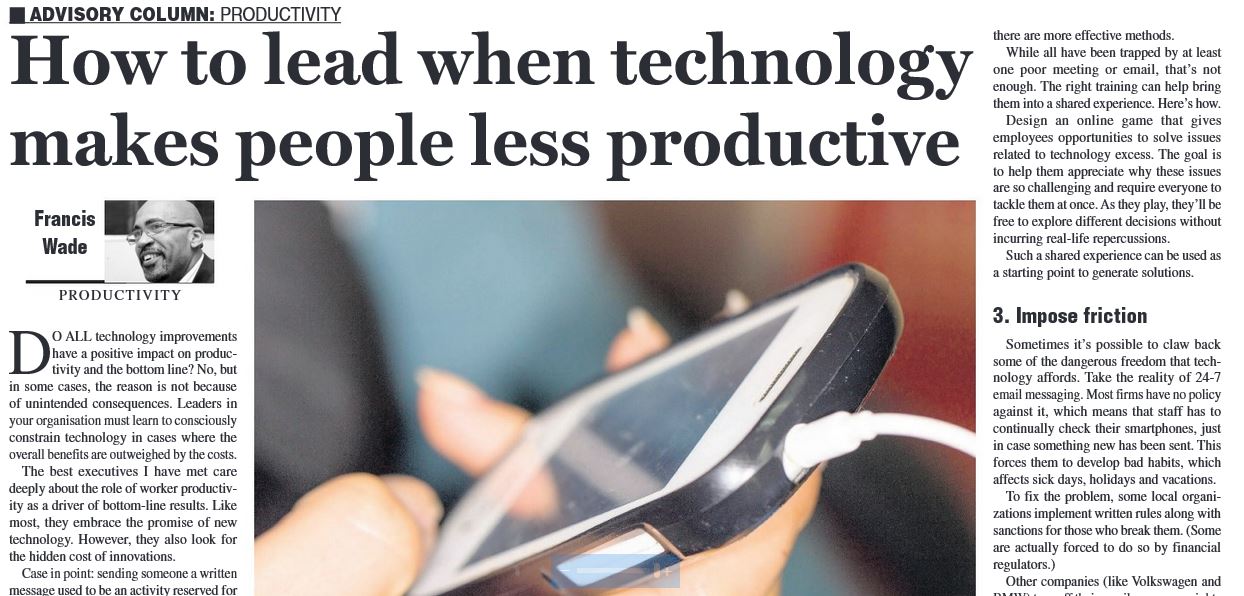Do all technology improvements have a positive impact on productivity and the bottom line? No, but in some cases, the reason is not because of unintended consequences. Leaders in your organization must learn to consciously constrain technology in cases where the overall benefits are outweighed by the costs.
The best executives I have met care deeply about the role of worker productivity as a driver of bottom-line results. Like most, they embrace the promise of new technology. However, they also look for the hidden cost of innovations.
Case in point: sending someone a written message used to be an activity reserved for the office. Typing pools were required to transmit even the shortest letter.
Fast forward to today’s world in which technology allows us to send text messages at night when we should be sleeping, while driving when we should be focused on the road, and during conversations when we should be listening. As a consequence of the latter, our meetings take longer than they should.
Furthermore, each employee has the power to drag down the productivity of their colleagues by simply using the cc: function. We have all been there. Two people engaged in a disagreement cc: other employees to gain support. By copying them on messages, they entangle hundreds of innocent bystanders.
These are all cases in which technology-based improvements in personal efficiency can lead to overall disastrous results. They all have a negative impact on the bottom-line, even though they are supposed to have the opposite effect.
What should leaders do to prevent technology from running amok? Should they become Luddites, ridding themselves of email? Here are three practical suggestions for your organization.
1. Track Waste
In most organizations, bad expenditures are difficult to hide for long. However, the time lost in low-quality social interactions involving email and meetings is an open secret that’s never confronted. Why? Only the rare company tracks group or individual time usage so the cost is invisible.
As a result, people who convene meetings or send bad emails never receive clear feedback. At best, they may overhear some vague murmurings or hear a passing mention in a performance review session. But the chances of a true change in behavior are slim.
The way to tackle this issue is to create a mindset: the path to success requires a sustained effort to eradicate waste, especially when it’s caused by new technology. Employees who are able to see waste clearly are more likely to try to eliminate it. As they look back to the past, they recall times when they suffered from the effects of poor-quality meetings and email messages.
2. Implement Training
The best way to create this new mindset isn‘t to exhort staff through speeches, slogans or posters. While these may help, there are more effective methods.
While all have been trapped by at least one poor meeting or email, that’s not enough. The right training can help bring them into a shared experience. Here’s how.
Design an online game that gives employees opportunities to solve issues related to technology excess. The goal is to help them appreciate why these issues are so challenging and require everyone to tackle them at once. As they play, they’ll be free to explore different decisions without incurring real-life repercussions.
Such a shared experience can be used as a starting point to generate solutions.
3. Impose Friction
Sometimes, it’s possible to claw back some of the dangerous freedom that technology affords. Take the reality of 24-7 email messaging. Most firms have no policy against it, which means that staff have to continually check their smartphones, just in case something new has been sent. This forces them to develop bad habits which affects sick days, holidays and vacations.
To fix the problem, some local organizations implement written rules along with sanctions for those who break them. (Some are actually forced to do so by financial regulators.)
Other companies (like Volkswagen and BMW) turn off their email servers on nights and weekends. This blocks staff from working for the company on their own time, when they should be resting.
Leaders who create such policies on their own accord have developed the ability to look ahead and predict the adverse impact a new technology will have. For example, if your organization were to give smartphones to the drivers of its delivery fleet, you should probably expect that texting and driving would ensue… along with its catastrophic consequences.
Multiply this simple case several hundred times across your enterprise and you may see: it pays to anticipate the moments when free technology destroys productivity. As an executive, you must balance the gains against the risks and do what no-one else can do: implement limits in order to preserve your bottom-line results.

